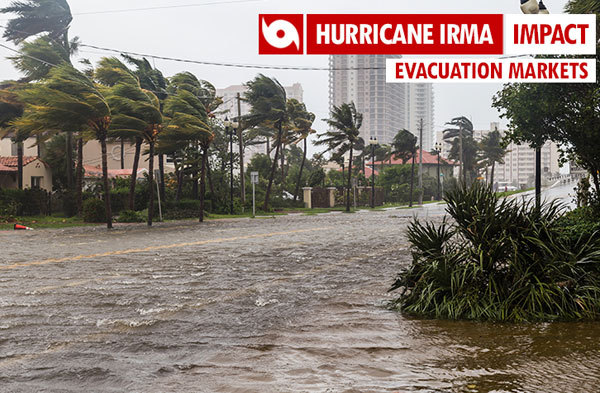✕

Column: industry Tag: Irma evacuations,hotel performance,Hurricane Irma Published: 2017-09-18 09:57 Source: Author:

Parts of Florida, including Fort Lauderdale, were evacuated ahead of Hurricane Irma, which caused flood and wind damage to the region. (Photo illustration: Annamarie Hudson)
HENDERSONVILLE, Tennessee—The pre-emptive response to Hurricane Irma was significant, with approximately 6.3 million people in Florida alone ordered to evacuate, according to CNN. To put that in perspective, Florida’s population was estimated at 20.6 million people in the 2016 census, which means that more than a quarter of the population was under an evacuation order.
For a picture of how that affected hotel performance, STR’s initial analysis focuses on two groupings of markets—those markets in the projected path of Irma and markets that were evacuation points. (STR is the parent company of Hotel News Now.)
This analysis details impacts with the current data set for the week ending 9 September. The demand impact to the industry in these markets will likely span months as rooms are booked for relief workers, volunteers, government employees, contractors, insurance adjusters, media and press and displaced residents.
It’s important to note that data submission was interrupted across dozens of hotels over this time period as preparations were made for Irma. As hotels in the path catch up on historical reporting in the coming weeks, market performance figures presented in this article will be materially revised. Also, due to the lack of participation in the Florida Keys from Thursday, 7 September to Saturday, 9 September, we were unable to include data from that market.
As the full extent of the damage to hotels in the path of the storm?is still unknown and continues to evolve, we will provide more data coverage in the coming weeks as details emerge.
Markets affected
Irma made landfall as a Category 4 hurricane in Florida the morning of Sunday, 10 September, making its presence felt in coastal cities across Florida. Irma moved through the state, eventually weakening into a tropical storm on Monday as it tracked through the southeastern United States. Many coastal markets in Florida, Georgia and South Carolina were affected as warnings were issued and evacuations began days prior to the storm making landfall. Flight cancellations topped 14,000?with hundreds of daily cancellations continuing through the weekend.
All southern Florida markets saw significant impact in the lead-up to Irma landfall (6-9 September). The greatest impact was felt in the east coast markets of West Palm Beach (-29.6% revenue per available room, compared with the same period in 2016), Melbourne (-42.5% RevPAR), and Miami (-47% RevPAR).
This was expected as early forecasts projected Irma to hit Miami and move up the East Coast.
As many Floridians and other coastal occupants evacuated, markets outside of Florida saw an influx of guests seeking shelter.
Markets in and around Georgia saw the largest increases in demand in the days leading up to landfall. Macon/Warner Robins, Georgia, reported significant year-over-year occupancy growth of 83.3%. Augusta, Georgia (+40.9%), Chattanooga, Tennessee (40.4%), and Atlanta (31.1%) also registered occupancy growth greater than 30%. Birmingham, Alabama, also felt the effects of the evacuation, realizing occupancy growth of 38.3%.
Supply
Some hotels will be offline for weeks or months for repair and renovation, but we do not anticipate an inventory loss shock like New Orleans experienced from Hurricane Katrina in 2005.
For reference, there are 3,695 hotels in the state of Florida, which account for almost 430,000 rooms. Nearly 56,000 of those rooms are in the Miami market, with Fort Lauderdale accounting for 31,000, West Palm Beach adding 16,900, Fort Myers has 12,000, and the Florida Keys adds 9,657.
Previous:Caution cools Ireland joy as it surpasses pre-bust peak
Next:De Vere gets new start with Starwood Capital investment
Hot key words
Hot Products
Popular Vendors